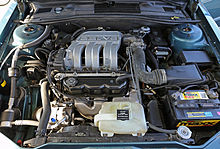Chrysler 3.3 & 3.8 engines
| Chrysler 3.3 & 3.8 engine | |
|---|---|
 | |
| Overview | |
| Manufacturer | Chrysler Corporation (1990-1998) DaimlerChrysler AG (1998–2007) Chrysler LLC (2007–2009) Chrysler Group LLC (2009-2011) |
| Production | 1990-2011 |
| Layout | |
| Configuration | 60° V6 |
| Cylinder block material | Cast iron |
| Cylinder head material | Aluminum |
| Valvetrain | Overhead valve |
| Combustion | |
| Fuel system | Sequential Multiple-Port Fuel Injection |
| Fuel type | |
| Oil system | Wet sump |
| Cooling system | Water-cooled |
| Chronology | |
| Predecessor | |
| Successor | Chrysler Pentastar engine |
This engine was Chrysler's first 60° V6 engine designed and built in-house for front wheel drive vehicles, and their first V6 not based on a V8. It was designed as a larger, more powerful option to the Mitsubishi 3.0 V6 in the minivans and debuted in 1990.
The engine has been produced in two major variants differing by their piston displacement: a 3.3 L (201 cu in) and a 3.8 L (232 cu in). The 3.3 was dropped after 2010 with the Chrysler minivans, and the 3.8 was dropped after 2011 with the Jeep Wrangler, ending 21 years in production.
Specifications
| Displacement | Bore | Stroke | Years | Power | Torque |
|---|---|---|---|---|---|
| 3.3 L (3301 cc/201.5 CID) | 93 mm (3.66 in) | 81 mm (3.19 in) | 1990–1993 | 150 hp (112 kW) | 180 lb·ft (244 N·m) |
| 1994–1995 | 162 hp (121 kW) | 194 lb·ft (263 N·m) | |||
| 1996–2000 | 158 hp (118 kW) | 203 lb·ft (275 N·m) | |||
| 2001–2010 | 180 hp (134 kW) | 210 lb·ft (285 N·m) | |||
| 3.8 L (3778 cc/230.6 CID) | 96 mm (3.78 in) | 87 mm (3.43 in) | 1991–1993 | 150 hp (112 kW) | 213 lb·ft (289 N·m) |
| 1994–1995 | 162 hp (121 kW) | 213 lb·ft (289 N·m) | |||
| 1996–1997 | 166 hp (124 kW) | 227 lb·ft (308 N·m) | |||
| 1998–2000 | 180 hp (134 kW) | 240 lb·ft (325 N·m) | |||
| 2001–2007 | 215 hp (160 kW) | 245 lb·ft (332 N·m) | |||
| 2008–2011 | 197 hp (147 kW) | 230 lb·ft (312 N·m)[1] |
History
The original 3.3 engine, as well as the larger 3.8, are pushrod engine designs. The 3.3 was introduced in 1990 and was joined in 1991 by the 3.8. Production on the 3.3 was stopped in 2010 while the 3.8 remained in production until May 2011 in Trenton, Michigan for the Jeep Wrangler. Both use a cast iron block and aluminum heads.
3.3
The first of the family, the 3.3 liter engine's actual piston displacement is 3,301 cc (201 cu in) with a 93 mm (3.7 in) bore and 81 mm (3.2 in) stroke. In 1994, the 3.3 got a 12 hp (8.9 kW) increase in power to 162 hp (121 kW) due to a new air intake. In 2001, the engine was fitted with a variable intake control system which boosted output to 180 hp (130 kW) at 5000 rpm and 210 lb⋅ft (285 N⋅m) at 4000 rpm. The engine was designed for transverse applications in Chrysler's minivans, but was also used in a longitudinal front-wheel-drive setup on 1993-1997 LH platform cars. It was last used in 2010 for Chrysler minivans before the introduction of the new 3.6 L Pentastar engine for the 2011 model year.
Designated EGA, the 3.3 was built at Trenton Engine in Trenton, Michigan. It uses SFI fuel injection, has roller tappets and features forged steel connecting rods, a one-piece cast camshaft, and either a cast aluminum or reinforced plastic intake manifold.
Vehicles using the 3.3 include:
- 1990–1993 Dodge Dynasty, Chrysler New Yorker, Chrysler Imperial, (replaced the 3.0 L Mitsubishi 6G72 engine)
- 1990–2010 Chrysler minivans
- 1993–1997 Chrysler Concorde/Dodge Intrepid/Eagle Vision
3.8

The 3.3 was bored to 3.78 in (96 mm) and stroked to 3.43 in (87 mm) to create a 3,778 cc (231 cu in) version.[1] This EGH version was also built at Trenton Engine in Trenton, MI.
The 3.8 got an increase in power of 12 hp (9 kW), for a total of 162 hp (121 kW) in 1994 via a new intake system. In 1998 the compression ratio increased for a total of 180 hp (134 kW) and 240 lb⋅ft (325 N⋅m). In 2001, like the 3.3 the 3.8 got a variable intake control system which boosted output to 215 hp (160 kW) at 5000 rpm with 245 lb⋅ft (332 N⋅m) at 4000 rpm.
Vehicles using the 3.8 include:
- 1991–1993 Chrysler New Yorker and Chrysler Imperial 150 hp (112 kW), 213 lb·ft (289 N·m)
- 1994–2010 Chrysler minivans
- 2004–2007 Chrysler Pacifica (CS)
- 2007–2011 Jeep Wrangler
- 2009–2010 Volkswagen Routan
SOHC
A single overhead camshaft was an addition to the lineup for 1993. Introduced with the 3.5 L engine, this design spawned the DOHC 2.7 L Chrysler LH engine, as well as the 3.2 L and 4.0 L variants.
References
- ^ a b "Jeep Specs & Upgrades". Chrysler LLC. Retrieved 2008-04-16.
- "Chrysler/Dodge 3.3". Allpar.com. Retrieved February 6, 2006.
- "The 2.7, 3.2, and 3.5 L engines". Allpar.com. Retrieved February 6, 2006.
